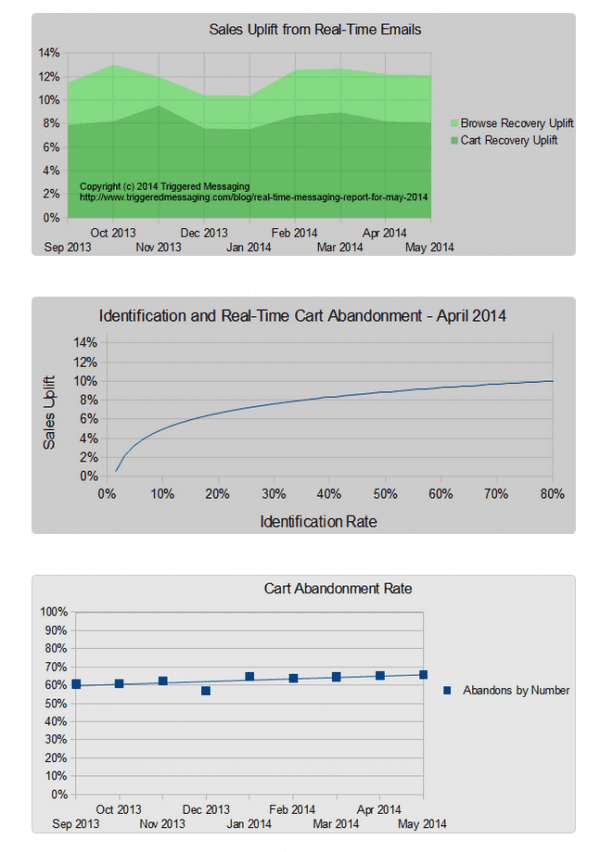Research showing how using event-triggered emails boosts open, clicks and retail sales
As customers of retailers, we have all seen triggered messages based on a response to an action we have taken, for example welcome emails on subscribing, onboarding emails after purchasing, and shipping reminders. More generally, they can be used by all types of businesses to welcome and engage prospects and customers where they're known as behavioural emails and are one of the key functions of Marketing Automation.
As marketers, we know they can be extremely effective, but research shows, fewer than half of business are using them. This post explains:
- Why triggered messages are effective,
- Typical results retailers can expect from triggered messaging
- Good scenarios for using them,
- Most importantly when they do or don't work.
In a follow-up post, I explain the technical options to send behavioural emails for retailers.
Why are Triggered Messages Effective?
Econsultancy reports that triggered email open rates are four times higher than newsletters. And the Direct Marketing Association reported 125% higher click-through rates. Our own data on sales uplift presented below shows a 12% increase in revenue.
The reason for their effectiveness is simple. It's an example of how marketing works better when the audience is engaged – as all those marketer who link their brand with topical events know well.
Real-time triggered emails get good results because they respond to subscriber actions and are relevant to them, so they benefit from current high engagement. Whereas routine marketing emails can be more like interruptions and are sometimes rejected as irrelevant.
Engagement is highest when emailing a confirmation of an expensive product a subscriber just bought, or a reminder about their holiday flight tomorrow.
When to Use Triggered Messages
Real-time abandonment recovery emails are the “silver bullet” for retailers using event-triggered messages. Our real-time marketing reports show 12% sales uplift from combined cart/form and browse abandonment emails emails). The charts below show the regular benchmarks Triggered Messaging Limited of sales uplift from triggered messaging and cart abandonment rates.

Notes:
- The identification rate is of all visitors to an eCommerce site, whether or not they use product or cart pages. There is a lot of variabilty between clients and data is confidential, so this chart just shows the trend line.
- Average Order Value of recovered purchase as opposed to regular purchases 7% Higher for a recovered purchase
- Average return from a single cart recovery email £12.88
- Average return from a single browse recovery email £1.56
The options for event-triggered emails in retail
There are many flavours of triggered emails, to deepen engagement with your brand, improve customer experience, and deliver upsell opportunities
- Browse Abandonment Emails. Sent to people who have looked at products, but not put anything in their cart. Acts as a reminder and an automatic bookmark so they come back to your site to look again.
- Cart Abandonment Emails. Sent to people who have put products in the cart but not purchased. A strong indicator of intent to purchase, and provides an easy way for shoppers to complete the purchase.
- Welcome emails. Introduce the product and explain its details. Is there online documentation? What are the obvious upsell possibilities (e.g. early check-in or Wifi for your hotel room).
- Onboarding sequence. You need customers to *use* your product, so they will buy more stuff, so send several emails containing hints and tips.
- Count-down emails, due date, or replenishment reminders. Similar content to welcome emails, but sent shortly before the product is due (e.g. for flights, holidays, pre-orders) or expected to need re-purchasing (e.g. consumables or subscriptions).
- Bookmarking. a shopper for a complex product such as a holiday or insurance policy can request an emailed copy of their current choice, so that they can return to it later.
- Request for Reviews. This is the rare example where a long delay is good, because you want unhappy customers to have disengaged so they won't open the email.
You can also include triggered messages within your traditional bulk email as dynamic content. These are personalized for the current subscriber, formatted in the cloud at open time, and included in the email as dynamic images. They work by (a) allowing personalization that is difficult for ESPs, such as leveraging product details and behavioral history from an eCommerce system and (b) adding real-time formatting so that you don't waste space or attention by promoting products that are out of stock or a sale that's over. Something better can be displayed instead.
For example:
- Recently viewed products to give similar benefits to browse abandonment.
- Trending products, or similar to those bought by the subscriber, to make the content more relevant and deepens engagement.
- Count-down timer for pending products such as holidays, to encourage the subscriber to open their emails and provide a place for upsell opportunities.
When Don't Triggered Messages Work
You can see we're being advocates of triggered messaging, but they're not always suitable. I would advise against investing in sending triggered messages in the following cases:
- You are not doing both eCommerce and email marketing
- Your business is too small, say less than £100k turnover per year
- You choose a free/cheap cart abandonment plug-in that comes with your eCommerce platform (you'll make some money, but not enough to matter).
- You choose a system (or custom services) that makes integration complicated.
- You choose a system that makes you use its own ESP for real-time emails so you double-up on the creative and management work.
So, these are the benefits and results you can expect from triggered messaging! In my next post I will look at the various methods of implementing triggered messaging for your business. There are 3 main options depending on your budget, your ESP and what you want to achieve. It's important to choose the option that's right for you. To understand the technical options see this post on the options to send behavioural emails for retailers.

Thanks to
Mike Austin for sharing their advice and opinions in this post. Mike Austin is a technologist with 14 years experience of email marketing. He co-founded an ESP in 2000 and co-founded
Triggered Messaging in 2011. You can follow connect on
LinkedIn.




 Thanks to
Thanks to 


